Table of Contents
This comprehensive guide to customer experience explains the actual meaning of customer experience, why it’s unavoidably important, and actionable methods that you can use to improve your organization’s resultant customer experience.
Those who regularly roam with their eyes wide open in the marketing corridor are unsurprised to see the evolution of customer experience from a post-sale entity only to the new separate terrain of competitive marketing.
It’s strongly disruptive for those who believe that the tried and trusted duo of product and price alone will catapult them into the higher altitude of success.
Though experts had declared that the next decade would see a spectacle of customer experience trumping the product, the speed of change has preponed it, as it has already arrived.
What is customer experience?
Experts and novices alike have failed to think about customer experience beyond customer service. Of course, it's an essential color in the kaleidoscope of the customer experience but not the kaleidoscope itself in its entirety.
It's mainly due to the curved and complex customer journey, which has stemmed from the multitudes of digital devices and channels. It has forced marketers to break the synonymic relationship between customer experience and customer service.
Now, it has to be viewed as an interaction between an organization and a customer throughout their relationship. This interaction is made up of three main components- customer journey, the brand touchpoints the customer interacts with, and the environments the customer experiences during their experiences.
Annette Franz, founder, and CEO of succinctly puts it as follows:
"Customer experience is the sum of all the interactions that a customer has with an organization over the life of the relationship with that company or with that brand."
Richard Owen, the Vice President of Dell Online Worldwide, defines customer experience as being the “sum total of the interactions that a customer has with a company’s products, people and processes. It goes from the moment when customers see an ad to the moment when they accept delivery of a product – and beyond.”
Clearly, customer experience is not a unicellular organism anymore. The tide of time has transformed it into a much-evolved multicellular thing.
Why is Customer Experience Important?
The point that deserves a significant pondering here is customer experience has always been a closely watched baby in any business. It was always cited as the "important" thing, if not the most important thing.
So, why has it now acquired a center stage like never before? Why are people claiming it as an "a-must- to-have amulet"? So much so that when the survey asked companies about their crucial top priorities, customer experience came out with flying colors.
It even defeated price and product - two of the most powerful baits for any business.
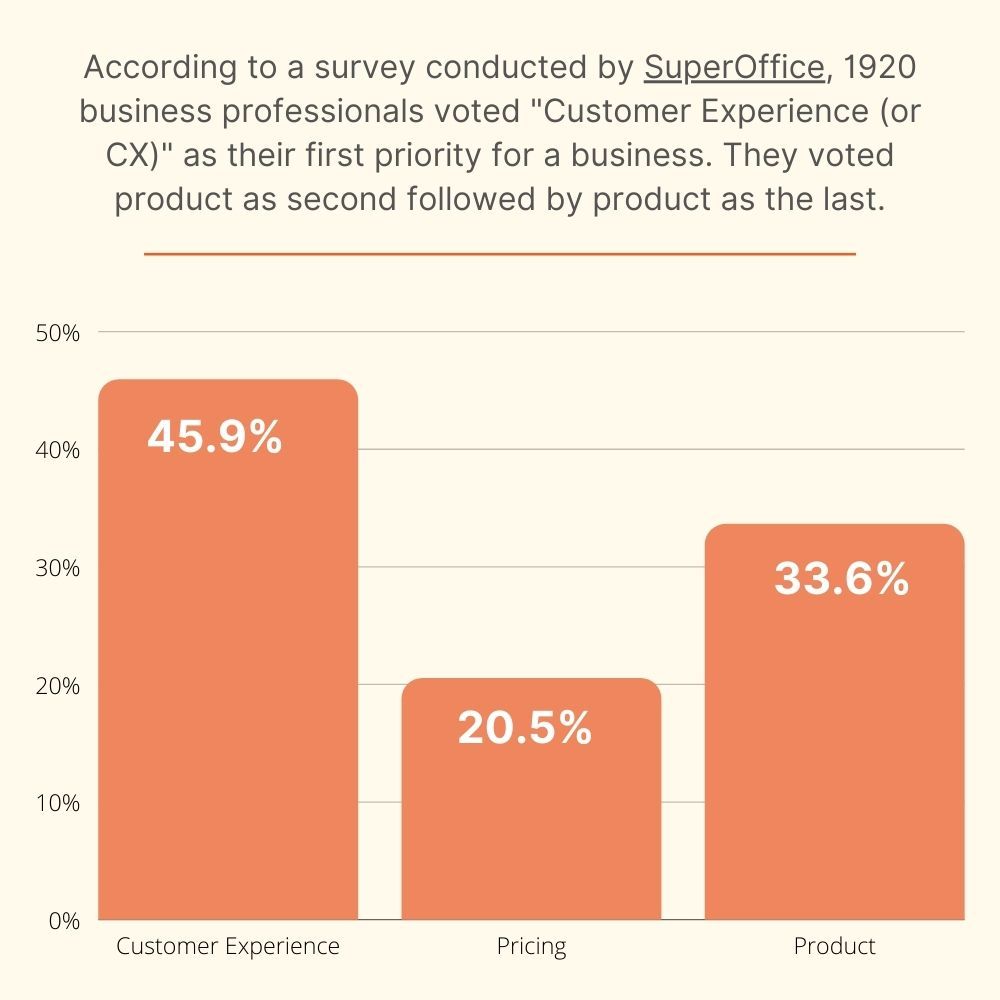
The answer is ensconced within the multiple overlays of economics, psychology, and societal shifts. So, here are the facts highlighting the importance of customer experience:
1. Enhanced purchasing power
In sharp contrast to the earlier times, industrialization and globalization have endowed people with more purchasing power. The financial muscle has become a bit more powerful, giving rise to the customers' need to be treated well by the businesses.
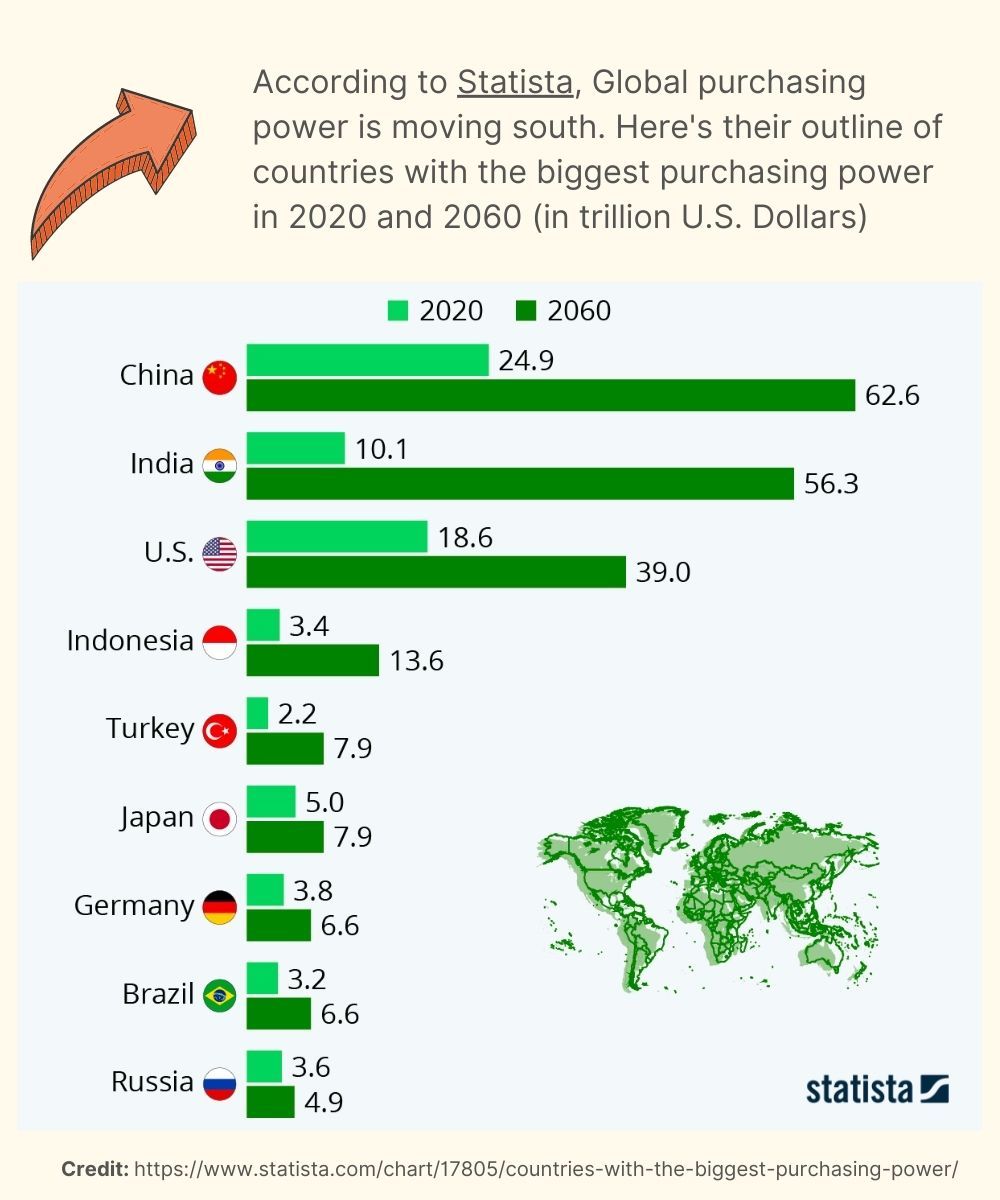
They want more than a mere product. That's why they no longer research just the product but the company and the experience that it provides. The kind of importance that customers put on good customer experience can be deduced from the fact that:
- 86% of consumers are willing to pay more to receive a better customer experience.
- Customers are willing to pay a price premium of up to 13% (and as high as 18%) for luxury and indulgence services.
- 66% of consumers think a company's customer service reputation is a critical factor while making a purchase decision.
2. Changing social ecosystem of consumers
Another aspect of this is the changing social ecosystem of consumers. The interactions they have with businesses, either directly or indirectly, are much higher as compared to the past.
They get exposed to giant retailers like Amazon or tech mavericks like Apple, and they get influenced by the superior level of customer experiences that they have been delivering consistently.
Subconsciously, they try to evaluate the customer experience they have been getting from their current brand against the bigwigs.
Paige O’Neill, the Chief Marketing Officer of SDL, explains this harsh reality when she says: "If you’re a financial services institution you’re not just competing with other financial services institutions, but you’re competing with Amazon and their experience. Or you’re competing with the expectation that customers have now when they go across and have the best experience they can possibly have."
It's actually a thinly veiled answer to the question: Why businesses are losing $4.7 Trillion per year due to poor customer service. Note that it was $62 billion just 5 years ago.
Of course, the above-stated gigantic loss is an accumulation of multiple adverse effects that a company has to bear due to poor customer experience. The list of such side effects is too long. The following infographic will give you a fair idea of how detrimental it can be for any business.

Let’s dive deeply into understanding how bad customer experiences result in those above-mentioned catastrophes.
➡️ Enhancement of the price sensitivity: Bad customer experience, in essence, is an organization's inability to interact well with its customer at any stage of the buying cycle. As the extent of this inability grows, customers' disgust with the organization also grows.
He starts to think about moving away from the company and indulges in the process to find a rationale to do the same. As it often happens, price is the soft target - making customers actively cost-sensitive. Once they find the same product at a cheaper rate - or even at the same rate, they don’t hesitate to switch.
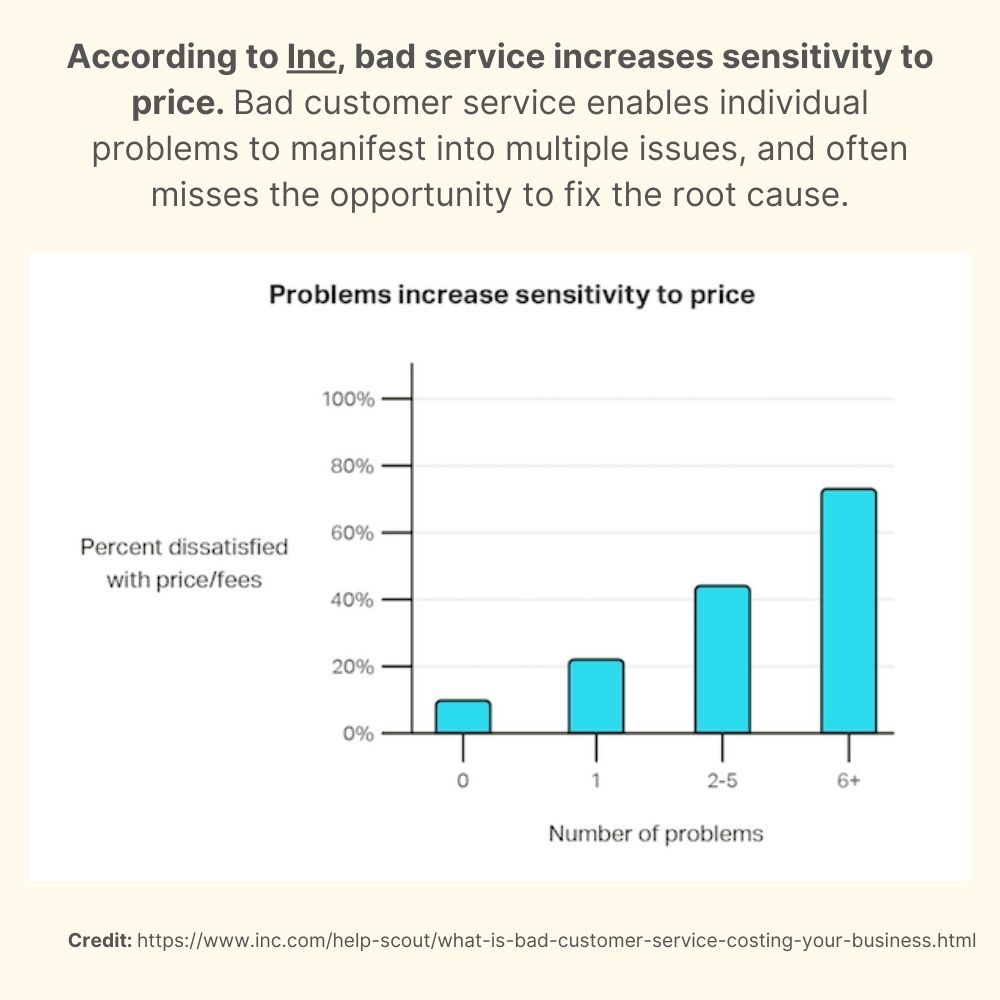
Observe that the problem here has a very definite meaning. If a customer is facing the same issue and is reporting it to the company, again and again, this is viewed as multiple problems, as it takes a separate amount of time to contact support and get a resolution.
That's what forms the crux of this PwC study: 1 in 3 customers will leave a brand they love after just one bad experience, while 92% would completely abandon a company after two or three negative interactions.
➡️ Killing of retention as well as loyalty potency: The poor customer service repels all in the same way. A poor customer experience, in that sense, is a great equalizer. Your old customers, not-so-old customers, or even potential customers abhor it with all their strength.
Clearly, they are not obliged to buy from you when they face a poor customer experience, certainly not in this era of overabundance- an outcome of a cannibalized competition. The possibility of getting better customer service from other brands is always there.
The fact is, the majority of the customers spend more time with a company because of a history of positive experiences. In fact, 70% will continue to do business with you if you resolve a complaint.
As per the consumer survey published in Goodman’s book Strategic Customer Service, a vast majority of customers would do business with a company again if their problem cost them less than $100 and if it was resolved by support in a reasonable time frame.
What it means is a good customer experience is coming to your rescue in undoing the previous bad customer experience.
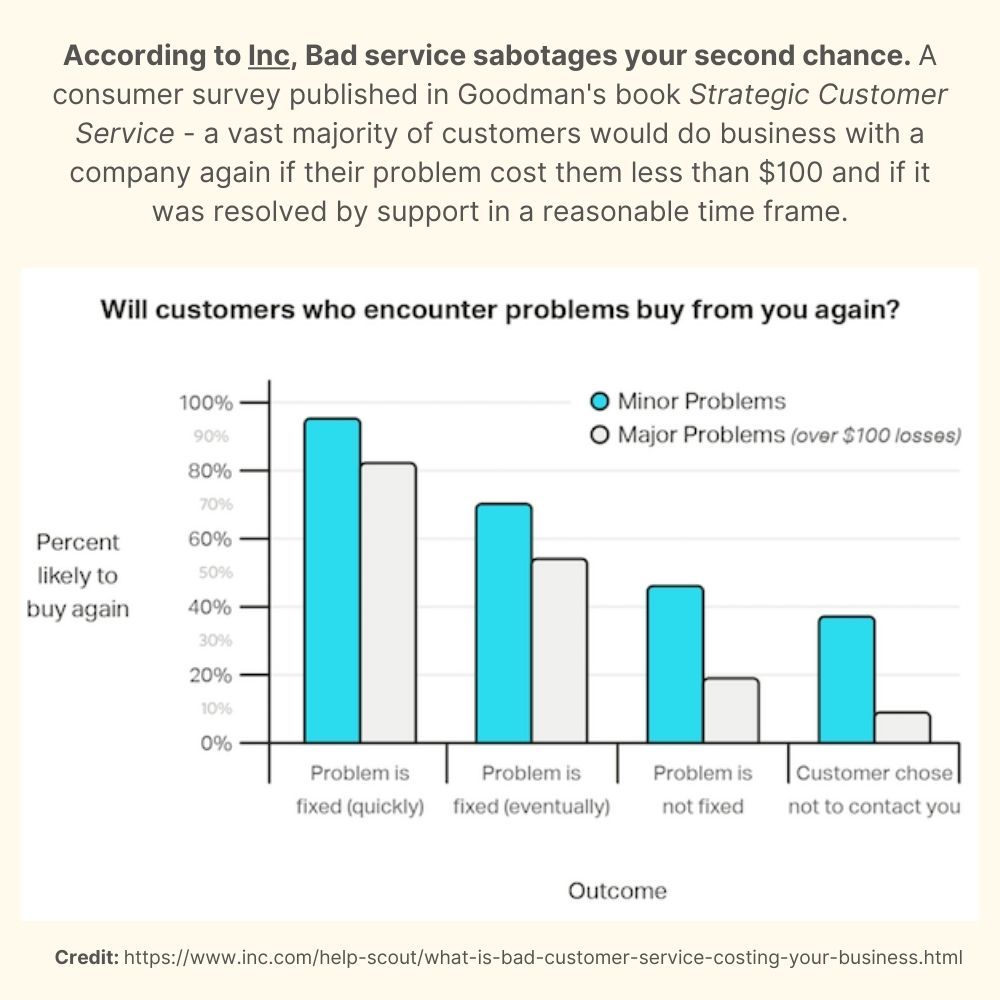
➡️ A damaged reputation: The Cost of Complaining survey identified the following key types of customers who have had a less than perfect experience: Walkers, Private Talkers, and Sulkers. A walker is someone who will simply walk away from your brand when he sees the bad experience.
The private talkers take the issue to the company. And sulker keeps criticizing the company by thinking that they are all the same. But the most dangerous is one who becomes a public talker by believing that the public must know about this. That’s when he becomes a bland antagonist.
As the traditional word of mouth now has taken the form of electronic word of mouth due to the intense digitalization of human life, he has the ability to promote issues across a large audience.
The threat of such a person is very real, as negativity spreads faster than positivity when it comes to the business.
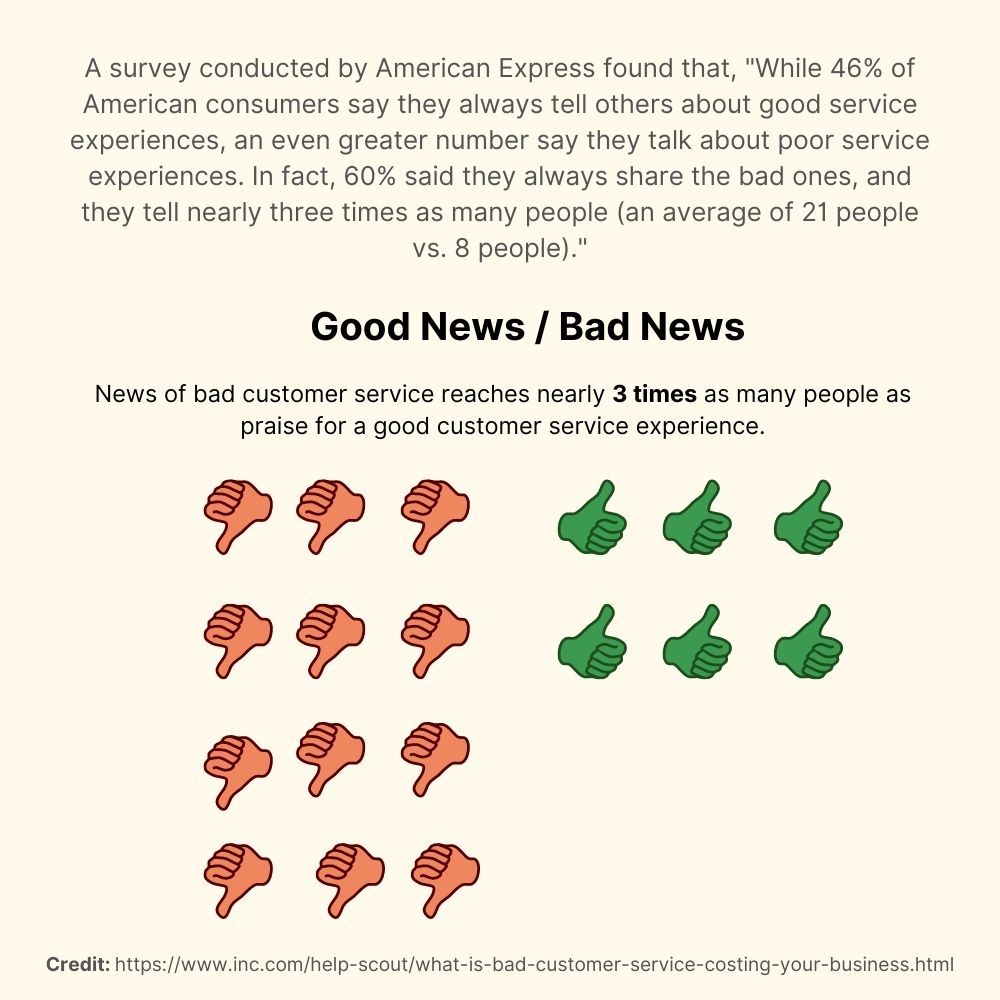
When it's human nature to trust what their peers and fellow customers have to say about the brand, it can act as a deterrent element for others to find a positive connection with your brand.
And the perception of customer experience affects the customer purchase decision intensely. 40% of customers begin purchasing from a competitor because of their reputation for great customer service.
Why does Customer Experience Matter for a Business?
A good customer experience encourages loyalty and can turn consumers into brand advocates. On the other hand, bad experiences do just the opposite, and that’s the critical reason customer experience matters the most. Let’s also understand a few other vital reasons for its importance.
1. Customer satisfaction has never been as important as it has become now
The road to customer satisfaction goes through meeting customer expectations, which have metastasized rapidly.

Note that a totally satisfied customer is the most bankable asset for any organization. He contributes 2.6 times as much revenue as opposed to a merely satisfied customer and 14 times as much revenue as a somewhat dissatisfied customer.
A good customer experience, with detailed pre-sales information and humane post-sales interactions, can easily churn out more satisfied customers by not just meeting their expectations but even surpassing them.
It’s important to point out that companies across the globe have an average customer satisfaction rate of 86%, leaving a lot of scope for improvement.
2. Customer experience boosts the bottom line - both directly and indirectly
The economic value lies at the intersection of customers' expectations and the delivered customer experience. When customers interact with your organization, they want to extract maximum value through minimum input.
That's their idea of satisfaction. A good customer experience, thus, can positively impact their buying behavior and result in heightened revenue, reduced service cost, and improved ROI.
3. Customer experience guarantees business resiliency
Customer-centric organizations are often rewarded by the market and customers. A great customer experience implicitly means that you have adapted to the customer needs well by designing end-to-end customer journeys that focus on customer relationship management.
It gives your business more resilience, shielding you from customer wrath and price sensitivity.
4. Customer experience ensures competitive advantage
A 2020 Gartner study confirmed that customer experience that focuses on "value enhancement" - helping customers to use a product efficiently, proactively anticipating customers' needs all the time, or validating purchase decisions - increases the probability of customer retention by up to 82%.
It then sounds perfectly logical why Tony Alessandra, President of Assessment Business Center, says: "Being on par in terms of price and quality only gets you in the game. Service wins the game.”
There is always a possibility that competitors may replicate the quality, product, and price dynamics you are having. But the touch of individualization and personalization that customer experience brings can be your own thing. It can become your product itself, and that's very hard to replicate, if not impossible.
Customers have always found it worthwhile to be with a company that is doing that, and that admiration is going to see exponential growth.
68% of marketing leaders say they are increasingly competing on the basis of customer experience. - Salesforce
How to Improve Customer Experience?
The benefits that a class-apart customer experience bequeaths upon companies are indeed tempting, making anyone put a foot on the experience pedal impulsively.
However, the reality is barring the top-of-the-shelf companies, very few have grasped it comprehensively and have made it their own exclusive expert.
A slew of hamperings - not knowing what exactly customers want, where they are, how to be there for them when they need you, clueless about adding value through customer experience - have impeded their customer experience endeavors.
The only way out is to decide key cornerstone actions involving a deeper understanding of customers and their surroundings and devising other subsidiary actions that revolve around them.
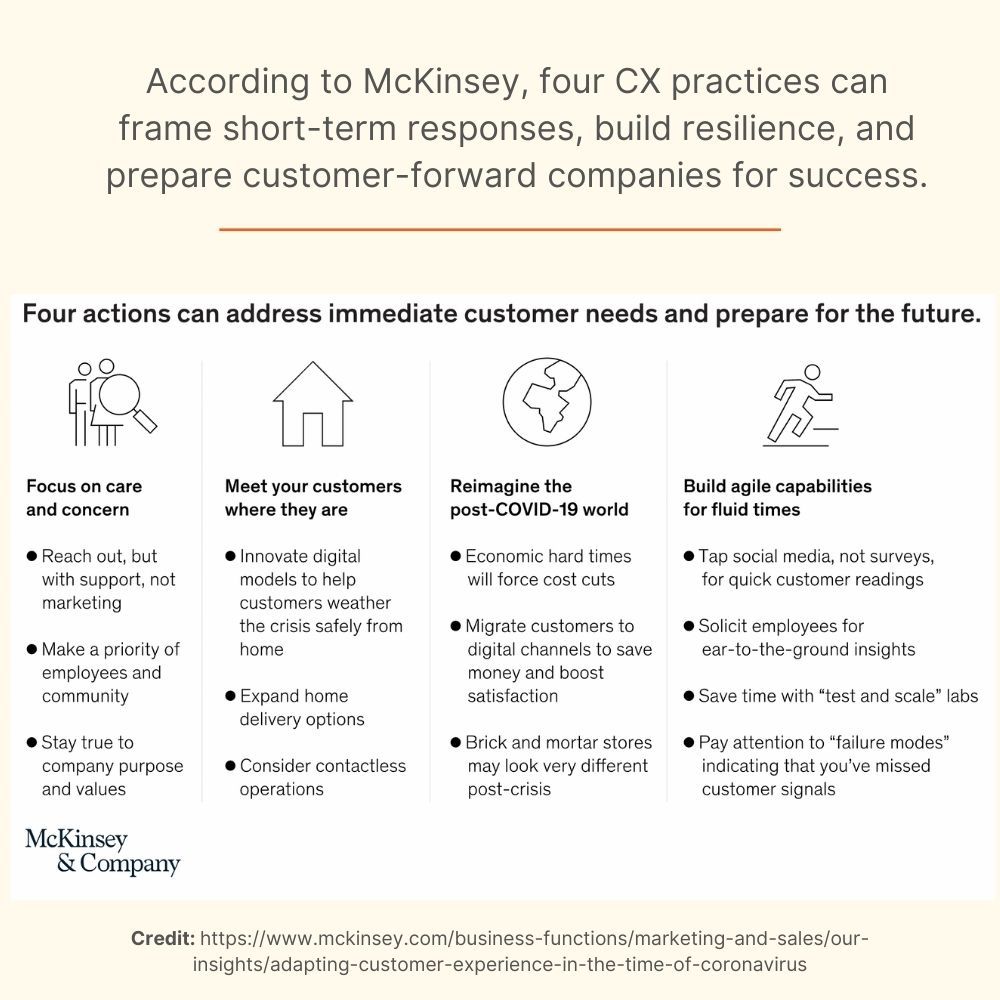
Here are the ten effective ways that can help in improving customer experience:
1. Map the customer journey judiciously
Understand your customer as clearly as you understand your own needs. Knowing first-handedly where customers come from, how they land on your various touchpoints, what they go through while traversing those touchpoints, and what they expect is the only reliable foundation on which the edifice of a stellar customer experience can be built.
Enunciating a clear customer journey map is, thus, the prime and first mover of customer experience.
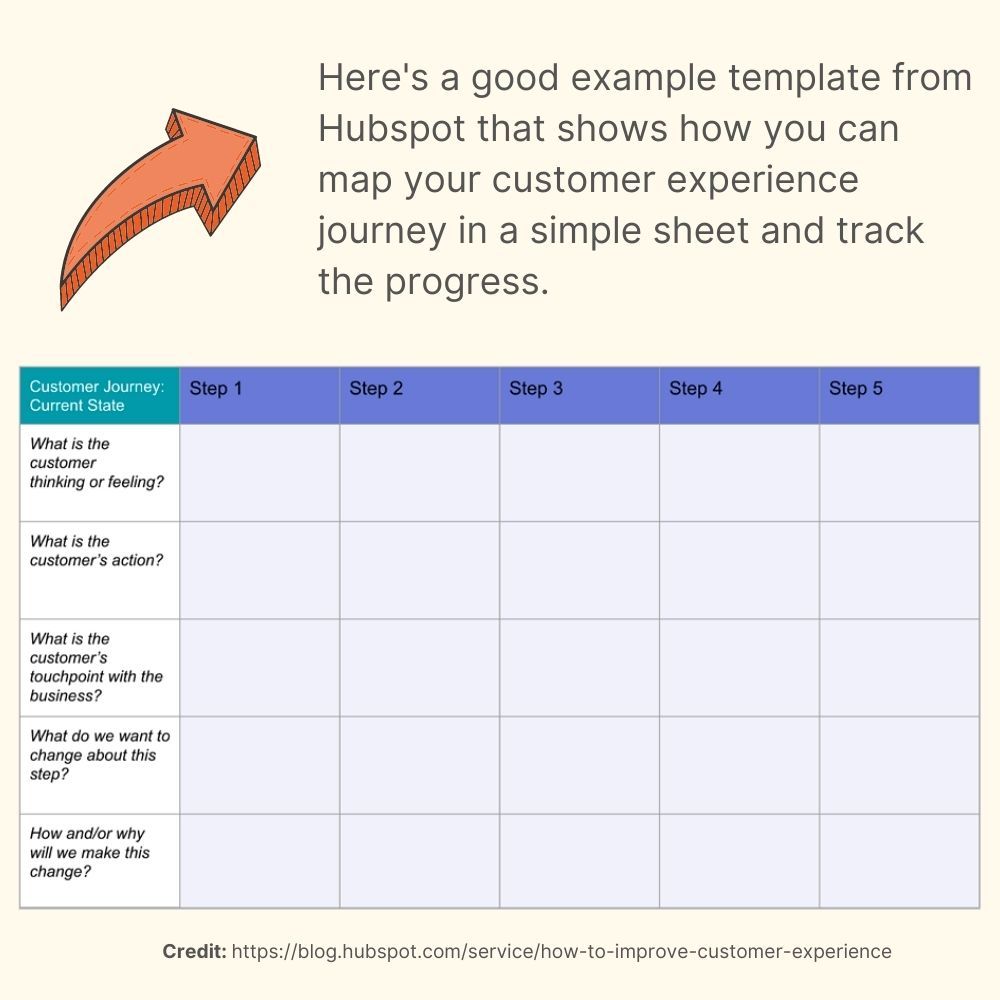
A customer journey map, in short, is a detailed sketch of every step your customers pass through while interacting with your organization—and that’s precisely why it is made up of engagements and touch bases beyond merely buying the product, like social media, advertisements in all forms, and case studies that adorn your company website.
Since customer experience is inherently and conceptually holistic in nature, it’s essential to plug in post-sales and pre-sales activities in your mapping.
Though common observation tells us that companies lean more towards activities that lead to sales, understandably as they bring revenue, paying heed to post-sales activities is necessary not just for a comprehensive customer experience but for sowing the seeds of customer retention.
Remember: Only a satisfied customer becomes a repeat customer.
Why is it important to map your customer journey?
The significance of a well-mapped customer journey shines more brightly once you get to know that it gives your employees a cradle-to-the-grave overview of the customer journey, letting them visualize the pain points and their possible panaceas.
This deepened visualization and sharpened understanding enable them to pinpoint exactly how and where their individual work affects the customer experience.
Once this sense of the significance of personal contribution percolates among ranks and files of your organization, it’s just a matter of time that superior customer experience becomes a cultural touchstone of your organization.
2. Hone in the omnichannel strategy
Once you have listed down the various modes through which customers can discover you and interact with you, the next step is to understand how customers behave on those channels and loop it seamlessly into your sales and marketing framework.
Note that this doesn’t just enhance your possibilities of getting in touch with your customers. But this is what customers want openly as well as secretly.
This expectation for omnichannel experience stems from two reasons:
- ➡️ Reason #1: Customers want a homogeneous, consistent, and familiar experience across all channels, making any kind of silos a sin.
- ➡️ Reason #2: In an almost avalanche-esque plethora of gadgets, customers expect joy and freedom of interacting through the mode of their preference. Expecting customers to prefer only one mode of communication, thus, is a sure way to plant you in the pot of irrelevance.
Why is it important to adopt an omnichannel approach?
➡️ Empowered convenience: Freedom of interaction ANYTIME and ANYWHERE through the preferred mode eventually gets translated into convenience, and convenience is the usual bulwark of the great customer experience.
That’s because it can give you a fair idea about the moments when customers want to act. In fact, Google identifies them as “micro-moments,” which are “intent-driven moments of decision-making and preference-shaping that occur throughout the entire consumer journey.”
Leveraging these crucial micro-moments without integrated and open lines of communication is akin to drawing lines on the water.
➡️ Roping in the power of data: Cutting-edge omnichannel strategies create tonnes of recurring, insightful, and actionable data, making it a rich database of consumer behaviors and preferences.
Its scientific utilization lets you respond to customer needs and trends more proactively. Moreover, this will also illuminate the “areas of friction” within the customer experience, which you can rectify with the newly-achieved power of data.
Common friction points:
- Complaint forms are too lengthy
- Call-to-action is buried in complex navigation
- The right content is hard to find
- Pop-ups intersect the key acts
- Re-entering the same information on multiple pages
- Challenges with using various devices
- No FAQ’s
3. Ace the Artificial Intelligence (AI)
Customer pains know no time clock. Sometimes, it’s humanly impossible to be there at all times for your customers. AI, with chatbots, can fill that glaring vacuum efficiently.
Infused with deep learning and advanced algorithms, they speed up response time and answer 80% of FAQs. Consequently, chatbots can save up to 30% in customer support costs.

Why is it important to have chatbots?
- Chatbots answer customer queries 24*7 even when your support team isn’t available. Ensuring prompt answers helps customers feel valued, the lynchpin of any good customer experience.
- Implementing bots as the primary customer contact can collect basic customer details that further the analysis.
- As opposed to humans, bots can be easily scaled during rush hours to deliver quality support without missing even an iota of conversation.
It’s then highly unsurprising that 30% of US consumers rate chatbot interactions as “very effective” in dealing with customer service issues. Why do you think this is possible? Activation functions make it possible to automate conversations - an impressive feat, indeed!
4. Integrate in-built self-service options
However well-trained and well-oiled your customer support team may be, it’s still a reactive response to your customers’ perennial and pigmy issues, incurring undue time lag and cost.
It then appears as a response of a strategic mind to let customers find solutions to their not-too-critical problems on their own.
By freeing up your support team from resolving tiny issues, it can focus on much graver issues expressed by customers, thereby bringing them back from the verge of churn.
Even customers don’t want to bother you for things that are resolvable at their rudimentary level.
- 70% of customers expect a company’s website to provide self-service channels like how-to content, product videos, case studies, etc. Clearly, it’s a win-win scenario for you and your customers.
- 77% of consumers report having used a self-service support portal.
Why is it important to integrate in-built self-service options?
The fact is, self-service comes with perks that traditional customer support teams cannot offer, hampering them from providing a highly coveted and distilled customer experience.
Self-service cures the hamperings by:
- Bringing the information that they need at their fingertips by using smart navigation and past experience.
- Giving them the tools they require for solving the smallest issue.
- Solidifying the brand reputation by devising frictionless client interactions.
5. Deliver emblematic customer service
The annals of businesses are abundant with scenarios where customers have churned out despite being satisfied with the product. More than often, the usual suspect is bad customer service.
And with 78% of customers backing out of purchase due to poor customer service, one doesn’t have to burden his eyes with binoculars to see the detrimental impact that it can have on the financial nerve of a company.
Here is an example of the actual churning that bad customer service caused:

Clearly, maintaining a higher standard of good customer service is key, as 67% of customers say their standards for good customer service are higher than ever. Understanding what good customer service means, thus, is important.
Usually, great customer service means a service that is:
- Fast (“real-time”)
- Personalized
- Experiential
- Proactive, giving out a resolution before an actual disruption occurs
6. Listen to customers—always
Your customer’s perception is your brand’s reality. Unadulterated understanding of what they expect, what they feel about their collaboration with you, what are the areas of improvement, their willingness to recommend your brand to others, thus, becomes vitally important.
The best way is to connect with your customers through all the possible channels and ask for feedback regularly.
This will place you in close distance with their expectations and what irritates them the most, particularly in terms of customer experience like:
- Nearly 60% of customers feel that long holds and wait times are the most frustrating parts of a service experience. (Zendesk)
- 70% of customers are irritated when their call is transferred from department to department. (Zendesk)
- In Microsoft’s report on the State of Global Customer Support, more than 75% of consumers expect customer service reps to have visibility into previous interactions and purchases.
When condensed in the tube of analysis, companies can use these nuggets of information in upping the ante of customer service.
Why is it important to always listen to customers?
- Careful implementation of feedback ensures that the end product and customer service will meet customer expectations and thereby make customers happy.
- The sheer hard work that goes into collecting feedback shows that you value your customers’ opinions, making them feel closely attached to your company.
- Honest, regular, and detailed feedback helps quantify the client satisfaction quotient and opens up new opportunities for upselling and cross-selling.
7. Learn from customer churn
Bain & Company suggests that a 5% increase in customer retention can increase your company's profits by 25% to 95%. It begins by analyzing the customer experience areas where there is low engagement.
Even if you fail to prevent the churning, try to find out why they left. Ask them to leave feedback and think about it seriously. Figure out the instances where your company fell short, and pass it on to the concerned people for a future remedy.
By making it easier for the customer to cancel his account and letting him go graciously, leave a good last impression—so when he decides to opt-in for the same product, you will be the first person to pop up in his mind.
Why is it important to prevent churn?
- Since low engagement is the precursor to the final, if not inevitable, churning, analyzing it lets you identify the customers who have the highest risk of churn.
- You can also gauge what percentage of engagement will cause churn and alert your customer success team about the same. It gives you the chance to proactively connect with customers before it's too late.
8. Engage with your customers throughout their life cycle

With countless touchpoints and ever-arriving gadgets, a modern customer journey is far removed from being streamlined and one-dimensional. It’s serpentine with characteristic twists and turns.
The only way to ensure that customers don’t drop off through myriad touchpoints and stages of a journey is to mother-hen them carefully across all the stages.
And since nothing repels customers more than a bad experience (After more than one bad experience, around 80% of consumers say they would rather do business with a competitor), great customer experience is the force that can push customers further down the sales funnel.
To ace this multi-stage experience perfectly, you need to observe the entire customer journey with a hawk’s eye and pinpoint the possible friction areas that may arrive at every stage.
For example, your website might be testing the patience of a potential customer with its endless buffering, making him disenchanted with you at the awareness stage only. Or product demos, webinars are forcing him to put too much information, forcing him to break his ties with you at the beginning of the BOFU.
If you weed out these thorns with a magic wand of superlative customer experience, you will be able to greet him at the finishing line - the fabled closing.
Why is it important to engage with your customers?
- A slight improvement in customer experience throughout the customer journey drastically enhances the lifetime value of customers.
- It guarantees a higher return on investment (RoI) and higher value for your brand.
- In the long term, a memorable customer experience at all stages results in lesser spending on marketing. Since it touches different people in different ways, it opens up whole new vistas for advocacy. And when you have vocal advocates, ads can easily take a backseat, ensuring no holes in your marketing wallet.
"The more advocates you have, the fewer ads you have to buy."
9. Build a customer-centric culture
A successful business is a myth without happy and satisfied customers. Customer-centricity entails a strategy and a culture of conducting business that emphasizes curating the best experience for the customer, and by doing so, ensures brand loyalty.
In essence, it’s a belief that the customer is at the center of a business's soul and body. Contrary to what many believe, a customer-centric approach doesn’t suck your finances dry-bone.
Small gestures, as explained below, go miles in letting customers feel valued and honored.
- ➡️ Delight your customers with gifts: Since the world is yet to see a joyous way of delighting a person than a souvenir of choice, strategic sparkling of gifts on customers’ key personal or professional moments can grant you a permanent space in their good books.
- ➡️ Grant them early access: A simple way to make your customers feel special is to provide early access to the newly launched product or services.
- ➡️ Shower discounts on high-spending customers: Raise your order value as well as repeat purchase rates by offering measured discounts to your regular buyers.
Why is it important to build a customer-centric culture?
The main reason why the customer-first approach works is its ability to instill the feel in the customers that you value them, and they are the core of your universe.
This constant psychological underpinning doesn’t just keep you on the top of their minds all the time. But it makes them more tolerant towards your slight mishaps and reduces their price sensitivity, the propellent of customer churn.
It echoed unequivocally in the research by Deloitte and Touche: Customer-centric companies are 60% more profitable compared to non-customer-centric companies.
10. Impart customer experience data to all teams
Customer experience is a grueling, never-ending battle that ought to be fought by the entire organization - and your CX team is handling just one front of it.
That’s why it’s imperative of the highest order that everyone in your organization has easy access to your customer experience findings.
This constant and first-hand brush with reality will help them introspect their work, causing optimization of daily yet mission-critical processes such as customer routing, workflow automation, and client tagging.
Why is it crucial to impart customer experience data to your teams?
- ➡️ Quicker customer redressal: Metasaas mentions that 31% of SaaS licenses end up unused, highlighting the need for clearing roadblocks as quickly as possible. Having real-time and comprehensive data regarding where your customers are likely to face obstacles enables your team to foresee user frustration and opt-in for proactive measures to smoothen the customer's journey.
- ➡️ Enhanced upsell opportunities: With an acute understanding of the right timing to reach out to customers, their preferred channels of communication, and their pressing needs, your sales team will be able to see newer upselling opportunities as clearly as daylight.
Based on the customer's timeline, you can identify whether to approach the client with re-engagement initiatives (product add-on) or a new closely-related product altogether, which can boost the overall revenue over time.



